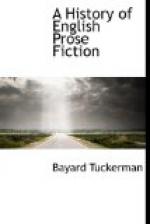Other causes, as well as the ignorance and brutality in which the lower classes almost necessarily lived, contributed to the number and impunity of criminals. It was only in 1736 that the streets of London, hitherto plunged at night in total darkness, began to be lighted for a few hours by lamps. The right of sanctuary, which still practically existed in such quarters as Whitefriars and the Mint afforded to criminals an easy and safe retreat beyond the reach of the law. The rougher elements of the upper as well as of the lower classes, made the streets impassable at night without great danger. They organized themselves into bands, and committed atrocious and wanton brutalities on inoffensive passers-by. One band, called the Modocs, indulged in the amusement called “tipping the lion” which consisted in flattening the nose of the victim on his face and boring out his eyes with the fingers. There were also the “dancing masters,” who made people dance by pricking them with swords, the “sweaters,” who pricked their victims with swords till they fell exhausted, and the “tumblers,” who set women on their heads and mutilated their limbs.[140] Others rolled women down hill in barrels, cut the faces of maid-servants, and slit the noses of watchmen. The criminal classes became so daring and numerous that the streets were insecure even in the day-time, “It is shocking to think what a shambles this country is grown!” wrote Walpole. “Seventeen were executed this morning, after having murdered the turnkey on Friday night, and almost forced open Newgate. One is forced to travel even at noon, as if one were




